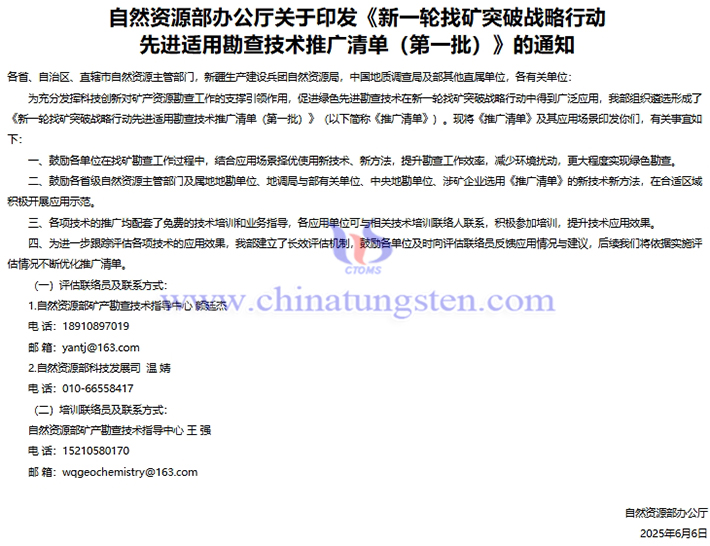Two Advanced and Applicable Exploration Technologies Related to Tungsten
- Details
- Category: Tungsten's News
- Published on Thursday, 19 June 2025 16:45
- Written by Zhenghua
- Hits: 271
On June 6, 2025, the General Office of the Ministry of Natural Resources issued the "List of Advanced and Applicable Exploration Technologies for the New Round of Strategic Actions for Mineral Exploration Breakthroughs (First Batch)", of which there are 2 technologies related to tungsten:

1. Field Testing Technology for Solid Minerals
Applicant: National Geological Experimental Testing Center
Technical Content: The laboratory is moved forward to the front line of mineral exploration, shortening the analysis cycle to 24-48 hours, realizing the measurement of samples as they are collected, and supporting exploration decisions in real time, which can change the traditional mineral exploration model and improve the speed of resource exploration. The technical capabilities formed by the project are evaluated through the field applicability of various technologies to achieve economic, practical and effective results. Strengthen and improve the technical system of field analysis equipment and standard methods, gradually form and improve the field rapid investigation and exploration technical system composed of "digital mapping-remote sensing-geophysical exploration-geochemical exploration-drilling (shallow drilling, drilling instead of slots, reverse circulation drilling, etc.)-analysis and testing-GIS big data", and further build a modern ground detection technical system coordinated by sky-air-ground (land and sea).
Technical Features: According to the characteristics of the combination of mineral elements, form an analytical instrument configuration plan, combine the Internet of Things control system and the mobile laboratory management system to form a modular and intelligent new generation of field rapid analysis and testing platform. The platform has coarse and medium crushers, disc mills, microwave digesters, X-ray fluorescence spectrometers, direct reading spectrometers, lithium-potassium analyzers, gold detectors and other instruments and equipment. It is suitable for field testing and analysis of 20 elements including lithium, beryllium, silver, boron, potassium, gold, copper, lead, zinc, iron, manganese, cobalt, nickel, arsenic, bismuth, tungsten, tin, molybdenum, chromium and antimony in whole rock, soil and sediment in remote areas such as forests, grasslands, plateaus and Gobi, as well as rare earth, uranium and copper mines and other important mineral mineralization and associated elements. It adopts green environmental protection technology, does not use acid and alkali, does not produce harmful waste, and does not cause damage and disturbance to the environment.
Application Cases: Case 1: Cooperating with Shenyang Center, supporting the verification of copper mine anomalies in the Greater Khingan Range, providing a basis for optimizing the drilling layout plan, reducing 16 drilling holes in total, shortening the working time by 68%, and delineating the intrusive rock-volcanic rock contact zone that is conducive to mineralization. Case 2: Cooperating with Xi'an Center, we supported geochemical anomaly verification in Altai, Xinjiang, analyzed 1,585 samples within 20 days, and obtained results within 1 hour. We accurately delineated multi-element geochemical anomalies and brought forward the 2024 exploration trench design to the second half of 2023.
2. Multi-element analysis and testing technology for strategic minerals
Applicant: National Geological Experimental Testing Center
Technical Content: Multi-element analysis and testing technology for strategic minerals is an indispensable key metal element for the development of national strategic emerging industries. We have innovatively established the simultaneous determination technology of rare, scattered, and rare earth elements in various ores such as tungsten, molybdenum, niobium and tantalum ores, the precise determination technology of heavy rare earth elements in Bayan Obo ores, and the precise determination technology of ion adsorption rare earth components. The new technical system and research model replaces traditional single-element testing methods such as organic reagent extraction-photometric determination, which can greatly improve the efficiency and quality of sample testing, greatly reduce the amount of chemical reagents, and reflect the concept of green development.
Technical Features: The hydrofluoric acid resistant system of inductively coupled plasma spectroscopy can effectively solve the problem that elements such as tungsten, niobium, and tantalum are prone to hydrolysis instability, resulting in low results. According to the different contents of niobium, tantalum, and tungsten in tungsten, niobium, and tantalum ores, different analysis methods are selected to accurately determine the contents of nearly 30 elements in niobium-tantalum ores, especially for high-content tungsten, niobium, and tantalum samples, which are more advantageous and suitable for the analysis and testing of multiple types of ore samples; the dynamic reaction cell method of inductively coupled plasma mass spectrometry (ICP-MS) can effectively solve the problem that inductively coupled plasma mass spectrometry (ICP-MS) cannot directly and accurately determine the heavy rare earth elements that are seriously interfered. This technology has been applied to the testing of batch samples; the establishment of ammonium sulfate solution extraction-inductively coupled plasma mass spectrometry provides a methodological basis for the analysis and testing of ionic phase rare earths in ion adsorption type rare earths.
Application Case: Case 1: The results of accurately determining niobium-tantalum ore using the hydrofluoric acid resistant system analysis method of inductively coupled plasma spectroscopy: Nb2O5 34.77%; Ta2O5 content 30.89%. Case 2: Accurate analysis of more than 2,000 pieces of Bayan Obo rare earth ore. Since the light rare earth content in Bayan Obo rare earth ore is very high, it seriously interferes with the accurate determination of its heavy rare earth elements. The dynamic reaction cell method of inductively coupled plasma mass spectrometry (ICP-MS) effectively solves the problem that inductively coupled plasma mass spectrometry (ICP-MS) cannot directly and accurately determine heavy rare earth elements.

- Chinatungsten Online: www.chinatungsten.com
- CTIA GROUP LTD: en.ctia.group
- Tungsten News & Price: www.ctia.com.cn
- Molybdenum News & Price: news.molybdenum.com.cn
- Tel.: 86 592 5129696; Email: sales@chinatungsten.com





 sales@chinatungsten.com
sales@chinatungsten.com